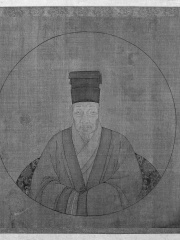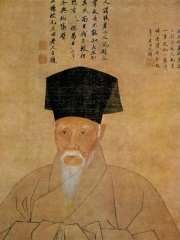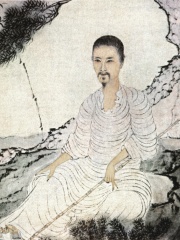
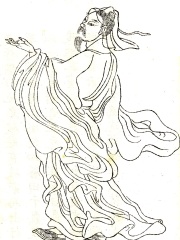
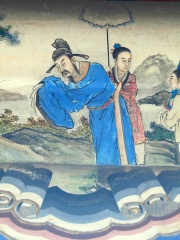
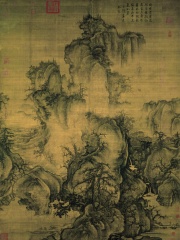

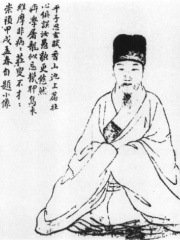
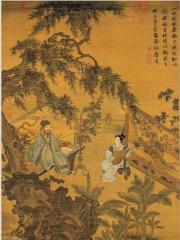
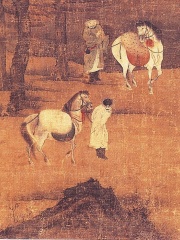
The Most Famous
PAINTERS from China
Top 10
The following people are considered by Pantheon to be the top 10 most legendary Chinese Painters of all time. This list of famous Chinese Painters is sorted by HPI (Historical Popularity Index), a metric that aggregates information on a biography's online popularity. Visit the rankings page to view the entire list of Chinese Painters.

1. Shitao (1642 - 1707)
With an HPI of 69.32, Shitao is the most famous Chinese Painter. His biography has been translated into 40 different languages on wikipedia.
Shitao or Shi Tao (simplified Chinese: 石涛; traditional Chinese: 石濤; pinyin: Shí Tāo; Wade–Giles: Shih-t'ao; other department Yuan Ji (Chinese: 原濟; Chinese: 原济; pinyin: Yuán Jì), 1642 – 1707), born into the Ming dynasty imperial clan as Zhu Ruoji (朱若極), was a Chinese Buddhist monk, calligrapher, and landscape painter during the early Qing dynasty. Born in the Quanzhou County in Guangxi province, Shitao was a member of the royal house descended from the elder brother of Zhu Yuanzhang. He narrowly avoided catastrophe in 1644 when the Ming dynasty fell to invading Manchus and civil rebellion. Having escaped by chance from the fate to which his lineage would have assigned him, he assumed the name Yuanji Shitao no later than 1651 when he became a Buddhist monk. He moved from Wuchang, where he began his religious instruction, to Anhui in the 1660s. Throughout the 1680s he lived in Nanjing and Yangzhou, and in 1690 he moved to Beijing to find patronage for his promotion within the monastic system. Frustrated by his failure to find a patron, Shitao converted to Daoism in 1693 and returned to Yangzhou where he remained until his death in 1707. In his late years, he is said to have greeted the Kangxi Emperor while the latter was visiting Yangzhou.

2. Gu Kaizhi (345 - 406)
With an HPI of 66.60, Gu Kaizhi is the 2nd most famous Chinese Painter. His biography has been translated into 27 different languages.
Gu Kaizhi (simplified Chinese: 顾恺之; traditional Chinese: 顧愷之; pinyin: Gù Kǎizhī; Wade–Giles: Ku K'ai-chih; c. 344–406), courtesy name Changkang (長康), was a Chinese painter and politician during the Eastern Jin dynasty (317–420). He was a celebrated painter of ancient China. He was born in Wuxi and first painted at Nanjing in 364. In 366, he became an officer (Da Sima Canjun or Assistant to the Minister of Defense, 大司馬參軍). Later he was promoted to royal officer (Sanji Changshi or Gentleman in Waiting to the Emperor, 散騎常侍). He was also a talented poet and calligrapher. He wrote three books about painting theory: On Painting (畫論), Introduction of Famous Paintings of Wei and Jin Dynasties (魏晉勝流畫贊) and Painting Yuntai Mountain (畫雲台山記). He wrote: "In figure paintings the clothes and the appearances were not very important. The eyes were the spirit and the decisive factor." Gu's art is known today through copies of several silk handscroll paintings attributed to him.

3. Mi Fu (1051 - 1107)
With an HPI of 66.57, Mi Fu is the 3rd most famous Chinese Painter. His biography has been translated into 32 different languages.
Mi Fu (Chinese: 米芾; 1051–1107) was a Chinese painter, poet, calligrapher and art theorist of the early Song dynasty. Born in Taiyuan, he was known for his landscape painting technique, later referred to as "Mi Dots", which involved the use of broad, wet ink dots applied with a flat brush. Mi Fu's poetry was influenced by Li Bai, while his calligraphy drew inspiration from Wang Xizhi. Mi Fu is commonly identified in art historical scholarship by art historians as one of the four major calligraphers of the Song Dynasty, along with Su Shi, Huang Tingjian and Cai Xiang. His major works include Zhang Jiming Tie (張季明帖), Li Taishi Tie (李太師帖), Zijin Yan Tie (紫金研帖) and Danmo Qiushan Shitie (淡墨秋山詩帖). Among these, Shu Su Tie (蜀素帖), also known as Nigu Shitie (擬古詩帖), is considered an example of running script calligraphy. Mi Fu described his calligraphy as "a collection of ancient characters", reflecting its roots in traditional styles; however, his work also incorporates elements that diverged from earlier conventions. His artistic style was later adopted and interpreted by his son, Mi Youren. Beyond his artistic achievements, Mi Fu was also known for having a distinctive personality and meticulous approach to his practice.

4. Guo Xi (1020 - 1090)
With an HPI of 66.28, Guo Xi is the 4th most famous Chinese Painter. His biography has been translated into 26 different languages.
Guo Xi (Chinese: 郭熙; pinyin: Guō Xī; Wade–Giles: Kuo Hsi) (c. 1020 – c. 1090) was a Chinese landscape painter from Henan Province who lived during the Northern Song dynasty. One text entitled "The Lofty Message of Forest and Streams" (Linquan Gaozhi 林泉高致) is attributed to him. The work covers a variety of themes centered on the appropriate way of painting a landscape. He was a court professional, a literatus, well-educated painter who developed an incredibly detailed system of idiomatic brushstrokes which became important for later painters. One of his most famous works is Early Spring, dated 1072. The work demonstrates his innovative techniques for producing multiple perspectives which he called "the angle of totality." This type of visual representation is also called "Floating Perspective", a technique which displaces the static eye of the viewer and highlights the differences between Chinese and Western modes of spatial representation. The following is an excerpt from his treatise, "mountains and waters": The clouds and the vapours of real landscapes are not the same at the four seasons. In spring they are light and diffused, in summer rich and dense, in autumn scattered and thin, in winter dark and solitary. When such effects can be seen in pictures, the clouds and vapours have an air of life. The mist around the mountains is not the same at the four seasons. The mountains in spring are light and seductive as if smiling: the mountains in summer have a blue-green colour which seems to be spread over them; the mountains in autumn are bright and tidy as if freshly painted; the mountains in winter are sad and tranquil as if sleeping. Another painting that can be attributed to him is The Coming of Autumn. Both paintings capture the seasonal atmosphere and are regarded as important accomplishments of the Song Dynasty. Guo Xi was often referred to as a "Northern Song master" when it came to painting. His work inspired many later artists and he even had landscapes dedicated to him. His lesser-known "Deep Valley" scroll painting depicts a serene mountain valley covered with snow and several trees struggling to survive on precipitous cliffs. The ink washes and amorphous brush strokes are employed to model surfaces that suggest the veiling effects of the atmosphere. One of Guo Xi’s techniques was to layer ink washes to build up forms and his "Deep Valley" is a masterpiece of the use of light ink and magnificent composition. His son later described how Guo Xi approached his work: "On days when he was going to paint, he would seat himself at a clean table, by a bright window, burning incense to right and left. He would choose the finest brushes, the most exquisite ink; wash his hands, and clean the ink-stone, as though he were expecting a visitor of rank. He waited until his mind was calm and undisturbed, and then began."
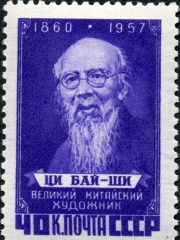
5. Qi Baishi (1864 - 1957)
With an HPI of 65.83, Qi Baishi is the 5th most famous Chinese Painter. His biography has been translated into 31 different languages.
Qi Baishi (1 January 1864 – 16 September 1957) was a Chinese painter, noted for the whimsical, often playful style of his works. Born to a peasant family from Xiangtan, Hunan, Qi taught himself to paint, sparked by the Manual of the Mustard Seed Garden. After he turned 40, he traveled, visiting various scenic spots in China. After 1917 he settled in Beijing. Qi was the master of Hu Jieqing, the wife of Lao She. The subjects of his paintings include almost everything, commonly animals, scenery, figures, toys, vegetables, and so on. He theorized that "paintings must be something between likeness and unlikeness, much like today's vulgarians, but not like to cheat popular people". In his later years, many of his works depict mice, shrimp or birds. He was also good at seal carving and called himself "the rich man of three hundred stone seals" (三百石印富翁). In 1953, he was elected president of the China Artists Association (中國美術家協會). He died in Beijing in 1957.

6. Han Gan (706 - 783)
With an HPI of 63.87, Han Gan is the 6th most famous Chinese Painter. His biography has been translated into 25 different languages.
Han Gan (simplified Chinese: 韩干; traditional Chinese: 韓幹) (c. 706–783) was a Chinese painter during the Tang dynasty. He came from a poor family in either Chang'an, modern-day Xi'an, Shaanxi; Lantian, modern-day Shaanxi; or Daliang, modern-day Kaifeng, Henan. As a young man, Han Gan was recognized by Wang Wei, a prominent poet, who sponsored Han in learning arts. Han became a student of Cao Ba, a court painter. After his studies, Han became a painter in the Tang court. Han painted many portraits with Buddhist and Daoist themes during his career; however, he is most widely remembered for his paintings of horses. He was reputed to have "learned from the horses in the imperial stables" and to be able to not only portray the physical body of the horse, but also its spirit. His reputation rose and surpassed that of his teacher. Horse painters of later generations studied Han. The horse as a central subject was continued by Li Gonglin of the Song Dynasty. He is honored with a crater named for him on Mercury.

7. Dong Qichang (1555 - 1636)
With an HPI of 63.84, Dong Qichang is the 7th most famous Chinese Painter. His biography has been translated into 23 different languages.
Dong Qichang (Chinese: 董其昌; pinyin: Dǒng Qíchāng; Wade–Giles: Tung Ch'i-ch'ang; courtesy name Xuanzai (玄宰); 1555–1636) was a Chinese art theorist, calligrapher, painter, and politician of the later period of the Ming dynasty.

8. Tang Yin (1470 - 1524)
With an HPI of 63.33, Tang Yin is the 8th most famous Chinese Painter. His biography has been translated into 23 different languages.
Tang Yin (Chinese: 唐寅; pinyin: Táng Yín; Cantonese Yale: Tong Yan; 6 March 1470 – 7 January 1524), courtesy name Bohu (伯虎) and Ziwei (子畏), was a Chinese painter, calligrapher, and poet of the Ming dynasty period. Even though he was born during the Ming dynasty, many of his paintings, especially those of people, were illustrated with elements from Pre-Tang to Song dynasty art. Tang Yin is one of the most notable painters in the history of Chinese art. He is one of the "Four Masters of Ming dynasty” (Ming Si Jia), which also includes Shen Zhou (1427–1509), Wen Zhengming (1470–1559) and Qiu Ying (c. 1495–1552). His influence on the art of contemporaries, like Cai Han, is notable. Tang was also a talented poet, and together with his contemporaries Wen Zhengming, Zhu Yunming (1460–1526), and Xu Zhenqing, he was one of the "Four Literary Masters of the Wuzhong Region".

9. Liang Kai (1200 - 1300)
With an HPI of 63.31, Liang Kai is the 9th most famous Chinese Painter. His biography has been translated into 22 different languages.
Liang Kai (Chinese: 梁楷; pinyin: Liáng Kǎi; c. 1140 - c. 1210) was a Chinese painter of the Southern Song Dynasty. He was also known as Madman Liang because of his very informal pictures. He was born in Shandong and worked in Lin An (later Hangzhou). He is known to have studied with the master Jia Shigu. He was awarded the rank of Painter-in-Attendance at the court of Jia Tai (1201-1204 CE, Southern Song Dynasty) where he was known for mastery in painting figures, landscapes, and other minor subjects. He was also awarded the Golden Belt, however he left it behind when he left his position at court to practise Chan Buddhism.
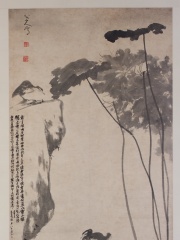
10. Bada Shanren (1626 - 1705)
With an HPI of 63.17, Bada Shanren is the 10th most famous Chinese Painter. His biography has been translated into 23 different languages.
Zhu Da (朱耷), also known by his pen name Bada Shanren (八大山人), was a late-Ming and early-Qing dynasty Chinese painter, calligrapher, and poet. He was born in Nanchang, Jiangxi, in 1626, at during the Ming-Qing Transition. Zhu was mentally ill and displayed erratic behavior. He was related to the House of Zhu, which was destroyed and executed by the new Qing dynasty. Fearing that he would also be purged and executed, he fled to a Buddhist temple and learned the teachings of Chan (Zen) Buddhism, becoming a monk for 30 years. He spent most of his early to mid-life in the Buddhist monkhood, returning to Nanchang when he was about fifty years old. He embarked on an artistic career soon after reentering secular life in 1680, producing works that featured his calligraphy, painting, and poetry. Most of the time, he painted simple subjects like flowers, plants, and animals and kept most of the given space empty. Toward the end of his life, he started painting more landscapes. Some of his artwork were metaphors on the fall of the Ming dynasty and its failure after being destroyed by the Qing. His poems often included obscure references.
People
Pantheon has 39 people classified as Chinese painters born between 345 and 1920. Of these 39, none of them are still alive today. The most famous deceased Chinese painters include Shitao, Gu Kaizhi, and Mi Fu.
Deceased Chinese Painters
Go to all RankingsShitao
1642 - 1707
HPI: 69.32
Gu Kaizhi
345 - 406
HPI: 66.60
Mi Fu
1051 - 1107
HPI: 66.57
Guo Xi
1020 - 1090
HPI: 66.28
Qi Baishi
1864 - 1957
HPI: 65.83
Han Gan
706 - 783
HPI: 63.87
Dong Qichang
1555 - 1636
HPI: 63.84
Tang Yin
1470 - 1524
HPI: 63.33
Liang Kai
1200 - 1300
HPI: 63.31
Bada Shanren
1626 - 1705
HPI: 63.17
Wen Zhengming
1470 - 1559
HPI: 63.11
Shen Zhou
1427 - 1509
HPI: 63.08
Overlapping Lives
Which Painters were alive at the same time? This visualization shows the lifespans of the 5 most globally memorable Painters since 1700.

